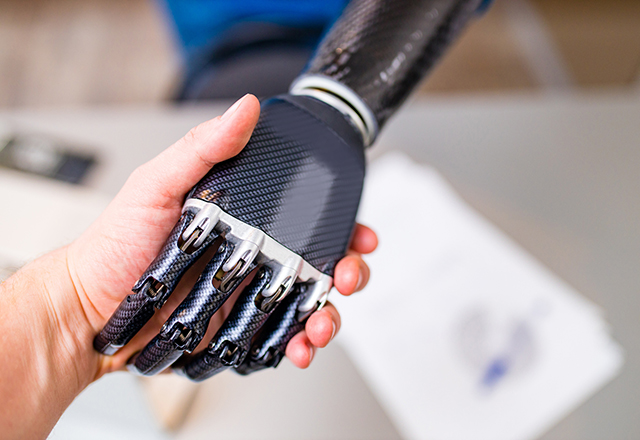In 2019, an estimated 2.3 million people in the United States were living with limb loss due to causes such as poor blood circulation from vascular disease and diabetes, trauma and cancer1. By 2060, the number of people living with limb loss in the U.S. is expected to increase by 145% to 5.6 million people.1 Prosthetic devices help people maintain independence, mobility and function.2 Rehabilitation following limb loss involves early prosthetic fitting, training and working with a multispecialty team that includes rehabilitation physicians, nurses, prosthetists, orthotists, physical and occupational therapists, and rehabilitation psychologists.3,4
An upper-limb prosthesis prescription includes components such as a terminal device, joints, socket and suspension, and can be cosmetic or controlled using body power via a cable and harness or external power via sensors that detect the muscle’s electrical activity.3,5 While research has continued to improve the sensory feedback, dexterity and complex movements of upper-limb prostheses, lack of functionality is part of the reason why people choose not to use a prosthesis.3,6 Areas for improvement identified by upper-limb prosthesis users include sensation, strength, coordination and grasp, although preferences and needs can vary widely from person to person.7,8
In March 2025, biomedical engineers at the Johns Hopkins Neuroengineering and Biomedical Instrumentations Lab designed a prosthetic hand that can not only differentiate objects of various shapes and textures, but also adjust grip strength to hold items such as a plastic cup filled with water without denting the cup, a filled metal water bottle, fruit and stuffed toys.9,10 Details were published in Science Advances. Compared to solely rigid or soft robotic hands, this hybrid hand’s three finger joints and two thumb joints that follow the anatomy of the hand can independently operate to produce grip patterns that have the force and compliance to pick up objects without damaging them.9 By being able to pick up everyday objects, this prototype represents an important step in understanding how to design a prosthesis that can more easily and accurately perform activities of daily living.
Other advances at Johns Hopkins include a 26-joint modular prosthetic upper limb developed by the Johns Hopkins University Applied Physics Lab as part of the Defense Advanced Research Project Agency’s Revolutionizing Prosthetics program, which was profiled in The New York Times in 2015 and Johns Hopkins Magazine in 2017.11-13 The prosthesis can curl up to 45 pounds, match the dexterity of a human arm and — through a surgical procedure called targeted sensory reinnervation — allow a person to feel and control the prosthesis with the mind through nerve remapping.11-13
With an estimated 5.6 million people in the U.S. expected to be living with limb loss by 2060, rehabilitation following limb loss and early prosthetic fitting and training are important in helping people maintain independence, mobility and function.1-4 Recent innovations have resulted in externally powered upper-limb prostheses that more effectively function and perform activities of daily living.
References
- Rivera JA, Churovich K, Anderson AB, Potter BK. Estimating recent US limb loss prevalence and updating future projections. Archives of Rehabilitation Research and Clinical Translation. 2024;6(4), 100376. https://doi.org/10.1016/j.arrct.2024.100376.
- Wurdeman SR, Stevens PM, Campbell JH. Mobility Analysis of AmpuTees (MAAT I): Quality of life and satisfaction are strongly related to mobility for patients with a lower limb prosthesis. Prosthetics and Orthotics International. 2017;42(5):498-503. doi:10.1177/0309364617736089
- Esquenazi A. Upper limb prosthetics. now.aapmr.org. Published September 20, 2014. Updated May 30, 2024. Accessed March 25, 2025. https://now.aapmr.org/upper-limb-prosthetics/
- Limb loss rehabilitation, prosthetics and orthotics. hopkinsmedicine.org. Accessed March 26, 2025. https://www.hopkinsmedicine.org/physical-medicine-rehabilitation/specialty-areas/limb-loss-rehab
- Berning J, Francisco GE, Chang SH, Fregly BJ, & O'Malley MK. Myoelectric control and neuromusculoskeletal modeling: Complementary technologies for rehabilitation robotics. Current Opinion in Biomedical Engineering, 2021;19, 100313. https://doi.org/10.1016/j.cobme.2021.100313
- Nazarpour K. A more human prosthetic hand. Robot. 2020;5, eabd9341. DOI:10.1126/scirobotics.abd9341
- Cordella F, Ciancio AL, Sacchetti R, et al. Literature review on needs of upper limb prosthesis users. Front Neurosci. 2016;10:209. doi:10.3389/fnins.2016.00209
- Brown JD, et al. Touching reality: bridging the user-researcher divide in upper-limb prosthetics. Science Robotics, 2023l8(83), eadk9421.
- Sankar S et al. A natural biomimetic prosthetic hand with neuromorphic tactile sensing for precise and compliant grasping. Adv. 2025;11,eadr9300. DOI:10.1126/sciadv.adr9300
- Candanosa RM. Feeling is believing: bionic hand 'knows' what it's touching, grasps like a human. hub.jhu.edu. Published March 5, 2025. Accessed March 26, 2025. https://hub.jhu.edu/2025/03/05/prosthetic-robotic-hand/
- Moncrieffe MV. APL's newest prosthetic invention lets users reclaim their sense of touch. hub.jhu.edu. Published Spring 2017. Accessed March 27, 2025. https://hub.jhu.edu/magazine/2017/spring/prosthetic-arm-with-sense-of-touch/
- Johns Hopkins Applied Physics Laboratory. Overview. Accessed March 27, 2025. https://www.jhuapl.edu/work/projects-and-missions/revolutionizing-prosthetics/overview
- Cott E. Prosthetic Limbs, controlled by thought. nytimes.com. Published May 20, 2015. Accessed March 27, 2025. https://www.nytimes.com/2015/05/21/technology/a-bionic-approach-to-prosthetics-controlled-by-thought.html#:~:text=Engineers%20at%20the%20Johns%20Hopkins,just%20like%20a%20regular%20arm.
Related Content
- Building Brain-Machine Interfaces That Are Here to Stay
- Innovations at the Intersection of Medicine and Engineering
- A CRISPR Future
Want to read more from the Johns Hopkins School of Medicine? Subscribe to the Biomedical Odyssey blog and receive new posts directly in your inbox.
